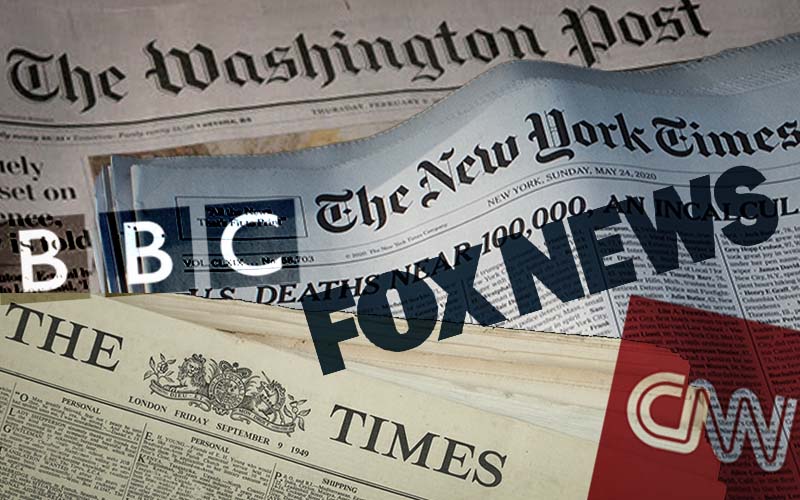
It is useful to recall how so much Western media coverage, from Hong Kong, of the deeply intimidating, three-month shut-down of arterial roads in 2014 and the unremitting violence of the 2019 multi-month insurrection was, in each case, dominated, first, by a constant retelling of narratives supplied by the activists and secondly, by intense coverage of all perceived lapses in official and police reactions. Added to this was a steady degree of media support for the protestors – regularly spilling over into acclamation – regardless, typically, of the unfolding disruption, chaos and destruction.
It is inconceivable that coverage by the mainstream media in the US or UK, or elsewhere in the West, would have been remotely this tilted had these events unfolded on their own doorstep, rather than on China’s doorstep.
Next, imagine, today, a leader in the New York Times (NYT) accurately observing that:
America’s appalling response to the COVID pandemic has cost the US trillions of dollars and thousands of preventable deaths. If only we had looked to and learned from China.
You certainly have to imagine this for it will never appear. In fact, the NYT has recently moved from repeatedly dismissing the Wuhan lab-leak conspiracy theory as fevered blame-averting by the Trump administration to arguing robustly that this is now a matter in need of serious revisiting.
Why, though, has this remarkable U-turn materialized? A pivotal aspect of the explanation is that history and current polling indicate that the Biden Democrats face a serious risk of losing their slim majorities in either the House of Representatives or the Senate – or both – in the mid-term elections due in November, 2022. Now that Trump is gone, the far-reaching anti-Trump media machine can get seriously behind Joe Biden. Re-energizing the (once derided) Wuhan lab-leak conspiracy theory provides an opportune argument, blessed with significant Sino-phobic potential to spur Democrat voter turnout and support in 2022.
Here is a fundamental question which the reflections above fairly raise: how is it that the US-led, global mainstream media now finds itself disfiguring its own credibility by persistently behaving in this argument-swapping, chillingly clannish, antagonistic manner?
A primary aspect of the broad explanation is the distorted, deep-seated self-image. In 2020, the NYT argued that US news organizations were, in contrast to those from China: “fully independent and [they] report on China as dispassionately and honestly as they do on the American government”. Moreover, the Voice of America, which is publicly funded, was characterized as being committed, by its charter, to accuracy and balance.
This is an exceptional example of warped self-understanding. It is as if the Iraq War in 2003 and its shocking aftermath have been erased from the NYT memory. When the time came for the invasion of Iraq almost all mainstream media commentary on that war was willingly derived from reporters “embedded” within the military operation.
Dan Rather, the American CBS network news anchor for 24 years, said after this experience, that that war had made “stenographers out of us”. Rather added that there was a fear in every newsroom of losing your job – or of being labelled as unpatriotic if you questioned the deceptions leading up to that war – and how it unfolded.
In 1995, Gore Vidal put his finger on the deep foundations of America’s singularly energetic, privatized propaganda regime. In an extended interview with the NYT, he was asked what shaped the way America worked and how those exercising power go about that task. “They don’t have to conspire,” Vidal said, “Because they all think alike – I mean who runs the [New York] Times, Harvard and the State Department and Hollywood? The country has always been an oligarchy of money.”
When John Rawls published his highly influential book, A Theory of Justice, in 1971, the world was a place where Western views and thinking had remained globally dominant for over 200 years. In 1995, the British political theorist, John Gray argued that for over 100 years a core Western belief, engendered by that what he terms the Enlightenment Project, was the empowering conviction that rationally-based, Western-liberal principles offer a foundational best option (which the world plainly should recognize) for the exercise and control of political power.
Today, the US feels more challenged and indignant than at any time for some decades. A wide range of writers, including, Fareed Zakaria, Tom Engelhardt, and Francis Fukuyama have stressed the central importance of the corrosion of the American polity from within, in explaining the primary source of this crisis. David Goldman, writing as “Spengler”, says that: “To much of the world America looks like a declining power, precisely because it is declining.”
Some, like the former US Ambassador to the UN, Nikki Haley, are preoccupied with finding external causes for the fix in which America now finds itself. In 2019, in a strident article in Foreign Affairs she advanced the case for increasing the US confrontational approach because, “China wishes to usurp our country’s leadership role, certainly in Asia and evidently in the rest of the world”.
The British analyst, Tom Fowdy, recently noted how many in the West accept emphatically skewed coverage of China as normal because the West is deemed the source of truth and enlightenment (see Gray, above) with a responsibility to save the backward non-West. The extraordinary development of China has shaken the foundations on which this hegemonic assumption rests, however. This is alarming, not just for Western governments glaring at China but also for the clear majority of their dominant, legacy media outlets. A material geopolitical phase shift is underway. This is distinctly unsettling for most Western media operations, which largely share the Haley view outlined above, prompting resort to a tireless pattern of accusation and rebuke – and sanitation, where needed.
There are abundant examples. Six months after CNN, along with virtually all media outlets, aptly branded the lethal violence at the Capitol on a single day, in January this year, an “insurrection”, the intensely destructive, multi-month period which brought Hong Kong to its knees in 2019 cannot be so labelled: what unfolded in Hong Kong were pro-democracy demonstrations according to CNN. The NYT, meanwhile, repeatedly refers to the “sweeping crackdown on pro-democracy forces in Hong Kong” since 2019, while air-brushing any serious examination of the terrifying, extended insurgency that those same forces incubated and unleashed.
Further evidence of the media-reliant, hostile shift in American foreign policy is signalled by the new Strategic Competition Act under which the US is set to spend hundreds of millions of additional dollars on challenging China, including $300 million: to spread negative news about the Belt and Road Initiative; to run anti-Chinese influence programs; to train journalists to counter Beijing and to expand the Chinese language operation of US media-arm, Radio Free Asia. There is, as it happens, scant doubt that this this colossal, taxpayer-funded amplification of Sino-scolding will also augment the malign proximate context within which intensifying anti-Asian attacks in the US obtain traction.
When we consider the development of geopolitics over the last 30 years, key turning points on the pathway leading to where we find ourselves today are clear.
The fall of the Berlin Wall, in 1989-1990, set Western celebratory analysis flowing, most conspicuously in the work of Francis Fukuyama who argued that we were approaching the end of history: that is, the global end point in the historical development of macro-political structures. This was not to last. Within twenty years, Fukuyama and others confirmed that the validity of his end of history narrative was dissolving. Moreover, it was clear that the rise of China helped foster the demise of that narrative.
Still, for most in the West, this rise also amplified positive expectations. Poverty was shrinking exceptionally fast in China, which was surely good, and remarkable new economic opportunities grew, year on year. Nowhere was this more apparent than in Australia, which enjoyed a huge trade surplus with China that underpinned a record-setting 28 year span of uninterrupted growth from 1991 to 2019.
In a recent essay, John Bellamy Foster argues that China’s rise also, fatefully, began to animate the movement towards a New Cold War, as it is increasingly described in the US. This has led to an almost bi-polar, US-led, switch of the Western mood from triumph to trepidation. China’s extraordinary rise has engendered significant disbelief, shock, envy and anger combined with regressing discernment.
It is clear that, despite concerted containment work by the US and allied governments, the world is changing conspicuously without seeking America’s consent. Restless pushback by an alarmed Western media has, accordingly, intensified.
This response is, however, not cost-free. Joseph Nye first popularized the term “soft power” in his 1990 book, Bound to Lead; The Changing Nature of American Power. Later, in 2012, he argued that in the information age, “credibility is the scarcest resource.”
The basic problem with becoming trapped within this acutely negative, China-commentary-loop is, as the analyst Eric Li observed, that leading Western media outlets are steadily destroying their own credibility: their “self-righteousness is mired in hubris”. Combined, one might add, with a deep apprehension of waning dominance.
Much harm is still being done by these outlets. But Li’s point is fundamentally cogent
As the New York Times and the Times of London each increasingly resort to high-pitched, Sino-phobic rebukes – including within their formal editorials – the number subscribing to their long-cultivated claim to be a paper of record is visibly fading. These legacy-media flagships are now leaders in progressively undermining that esteemed soft power. And they look set to continue prosecuting this edgy, corrosive project with uncommon zeal. The aim is not to signal ebbing confidence in the merits of their own, long-dominant system, of course. That is, however, the distinct, simultaneous message being sent to the rest of the world.
For the other articles in the White Man’s Media series, please see here.




